new posts in all blogs
Viewing: Blog Posts Tagged with: austria, Most Recent at Top [Help]
Results 1 - 17 of 17
How to use this Page
You are viewing the most recent posts tagged with the words: austria in the JacketFlap blog reader. What is a tag? Think of a tag as a keyword or category label. Tags can both help you find posts on JacketFlap.com as well as provide an easy way for you to "remember" and classify posts for later recall. Try adding a tag yourself by clicking "Add a tag" below a post's header. Scroll down through the list of Recent Posts in the left column and click on a post title that sounds interesting. You can view all posts from a specific blog by clicking the Blog name in the right column, or you can click a 'More Posts from this Blog' link in any individual post.

By: Jerry Beck,
on 9/14/2016
Blog:
Cartoon Brew
(
Login to Add to MyJacketFlap)
JacketFlap tags:
Feature Film,
Titles,
Austria,
Tom Hanks,
A Hologram for the King,
Benjamin Swiczinsky,
Johannes Schiehsl,
Neuer Österreichischer Trickfilm,
Santiago López Jover,
Tom Tykwer,
Conrad Tambour,
Add a tag
Vienna-based studio NÖT shares the unedited opening sequence of the Tom Hanks-starring "A Hologram for the King."
The post The Tom Hanks Film ‘A Hologram for the King’ Had An Inventive Cartoon Sequence That Was Cut appeared first on Cartoon Brew.
A music video for Ogris Debris' "See The World."
The post ‘See The World’ by LWZ appeared first on Cartoon Brew.
As per Con tradition, we slept in on Sunday. Not because of wild parties on Saturday night, but because we were a bit tired, and we could, and there wasn’t anything scheduled on our agenda.Today’s surprise on the Press Room menu was a nice TexMex chili. We haven’t noticed many Mexican or Latino restaurants in […]
We arrived back at the convention center bright and early, and were pleasantly surprised to discover that the press room was serving breakfast! After a brief tutorial on the Jura coffee maker (no… not a “coffee maker”… a “coffee juke box”!), I had a nice cup of normal (black) coffee with crema, and a few slices […]
[Please tolerate any typos… this is being typed on a European laptop… z and y are switched, thereäs all sorts of rearranged characters, and the spellcheck is Deutsch.] ReedPOP is hosting their first Vienna Comic Con this weekend! Looking at the calendar, this coincided with my annual ten-day Thanksgiving vacation (which uses only three vacation […]

By: Mohamed Sesay,
on 6/28/2015
Blog:
OUPblog
(
Login to Add to MyJacketFlap)
JacketFlap tags:
Austria,
cambridge,
*Featured,
Ludwig Wittgenstein,
philosophy of religion,
philosophy of language,
Quizzes & Polls,
QZZR,
Philosopher of the Month,
philosopherotm,
quiz,
Philosophy,
Add a tag
This June, we’re featuring Ludwig Wittgenstein as our philosopher of the month. Born into a wealthy industrial family in Austria, Wittgenstein is regarded by many as the greatest philosopher of the 20th century for his work around the philosophy of language and logic. Take our quiz to see how well you know the life and studies of Wittgenstein.
The post How well do you know Ludwig Wittgenstein? [quiz] appeared first on OUPblog.
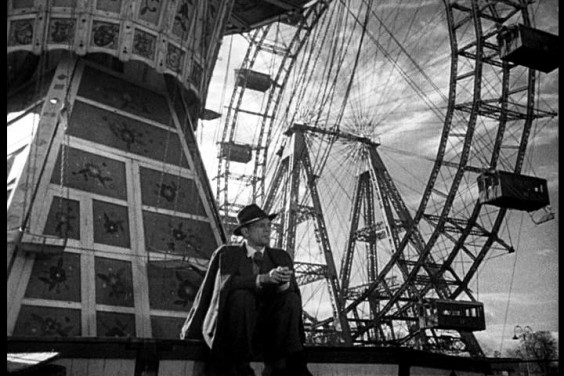
This is from “The Third Man”. Has anyone spoofed this scene, perhaps with Deno’s Wonder Wheel in Coney Island?
While fans were cursing the fates here in the U.S. as they tried to score tickets to New York Comic Con, fans in Austria were jubilant over the announcement of Vienna Comic Con, scheduled for 21-22 November at the Vienna Messe.
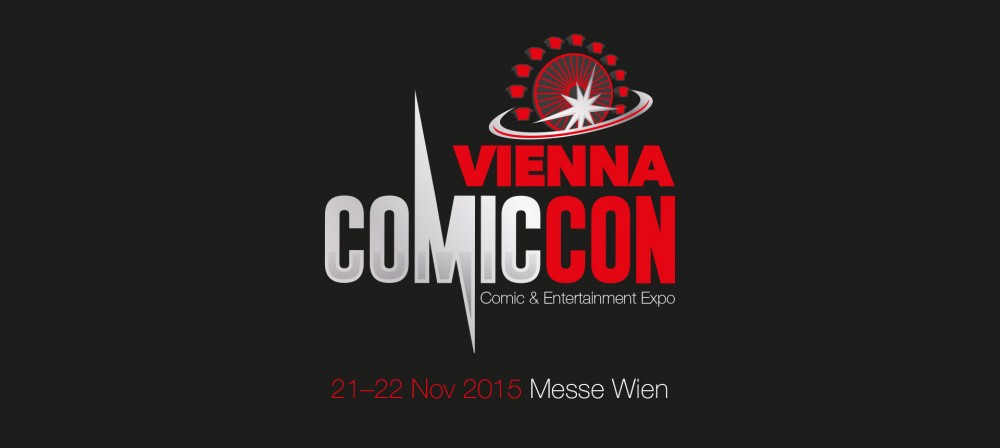
Why is there a Ferris wheel in the logo? It’s a nearby landmark, and one of the largest in the world! (Auf Deutsch: Ree-zen-rahdt … so fun to pronounce!)
So… the Vienna Messe… What’s it like? Well, for starters, Reed Exhibitions, the parent company of Reed POP, manages the venue (as well as one in Salzburg, but the Mozartkluge and the Trappists despise each other, so a fan expo there is unlikely).
It was rebuilt in 2001, and looks great. (Here’s a photosphere “streetview” of the convention center. Nicely laid out, and lots of light! And those partitions! Vienna Woods!) The exhibition acreage places it somewhere between Denver and San Diego.
It is served by two subways stations (use Krieau). If you have time, get off at Praterstern Bahnhof and wall along Ausstellungsstrasse! Or Strasse des Ersten Mai! If you prefer streetcars, ride to the terminus at Prater Hauptallee and walk a kilometer to the Messe.
It’s part of the Vienna Prater. Think “Central Park”, double it, then add a convention center, a sports stadium, an amusement park, community gardens, a golf course, a streetcar line… (Darn… most of the Wurstelprater will be closed then. But the Wintermarkt will be open! Glühwein am Wien!)

The grey square on the left is the convention center.
There are three main areas of the convention center:
- Exhibition Center: 593,692 sq.ft. total.
- The Con will be in Hall D, 95,454 sq.ft., a little bit larger than the Artist Alley at New York Comic Con.
- According to the 2015 price list, the cost for an exhibition hall is €6.12 per square meter for two days, or €54272.16 for Hall D. $61,580 at current exchange rates. (I wonder if Reed POP gets an employee discount for renting a Reed Exhibitions site?)
- Congress Center OG (Obergeschoss = upper floor)
- Three restaurants and a bar
- the Schubert Hall, which can seat 240.
- Congress Center EG (Erdgeschoss = ground floor)
- Three rooms: Stolz (400), Lehár (1005), and Strauss (1,435)
I really hope there’s a Café-Konditerei nearby. Sachertorte, Kaiserschmarr’n, Wiener Melange… *sabber*
Need some quiet time? Waltz (or Moonwalk!) on over to the Danube, two blocks away.
Is there a con wars?
One month before will be Vienna Comix, two miles away at the Marx Halle. It’s been taking place twice a year since 1993, and last year’s Fall show drew 6,000 fans. The big draw(er) for the next show? Don Rosa. Dayammmmmn…
And then there’s “Comic Con Vienna“, scheduled for September! It’s (at least) their second year, and while it’s more of what we old-timers would call a science fiction convention, it looks like a fun show!
I had planned on attending the Paris Comic Con in late October, but since this show coincides with my annual Thanksgiving vacation, it looks like I’ll be heading to Vienna before I make my way to Nebraska!
Here’s the official PR:
Vienna Comic Con Premieres This November!
+++ Vienna to become the centre of European pop culture with a world-class weekend of artists, celebrities, video games, collectibles and entertainment +++
© ReedPOP
VIENNA (13th May 2015). – On the 21st and 22nd of November 2015 the first edition of „Vienna Comic Con“ premieres at Messe Wien in Vienna, Austria. The two-day pop culture and gaming event will be produced by Reed Exhibitions Messe Wien in cooperation with ReedPOP, the world’s leading producer of pop culture events including New York Comic Con and the PAX video game shows.
New Comic Con Hotspot
Vienna Comic Con will bring the best of pop culture to central Europe with a vibrant exhibit hall floor, entertainment and panels, and the opportunity for guests to meet favourite pop culture celebrities. Just one of the highlights: ReedPOP U.S. is working with Vienna Comic Con to present an International Cosplay Competition, the winner of which will be sent to Chicago Comic & Entertainment Expo (C2E2) to compete in the championship finals.
Pop Culture Favourites On Board
Just a few of the companies that have already agreed to participate include Egmont publishers; Panini Verlags GmbH; Figuya; Manga-Mafia; KAZÉ Manga & Anime; Microsoft; Sony Computer Entertainment; Ubisoft; and Legend Icon.
”We aim to make Vienna Comic Con the leading pop culture event in central Europe,” says Dr. Barbara Leithner, New Business Development at Reed Exhibitions. “Fans at Vienna Comic Con will experience unique programs and events, and meet pop culture creatives from all over the world.”
Vienna Comic Con is slated for Hall D at Messe Wien in Vienna. Show hours are Saturday, 21st November from 10:00 to 19:00, and Sunday, 22nd November from 10:00 to 17:00. For more information on tickets, guests, programming and the latest Vienna Comic Con news, go to www.vienna-comiccon.com.
Reed Exhibitions hosts over 500 events and is the world’s leading organiser of conventions. Since its start in 2006, ReedPOP has staged top-ranking pop culture events including New York Comic Con, PAX Prime, Star Wars Celebration and C2E2 in the United States, and introduced Comic Con events across the globe in Europe, India, Asia and Australia.
“Vienna Comic Con will bring together the worlds of comics, movies, television, toys and games,” says Matthias Limbeck, managing director at Reed Exhibitions in Austria. “It will be the place where the creatives, stars and heroes meet their fans, who in turn will be able to experience the latest trends in their favoured fields of international popular culture.”
ABOUT REEDPOP
ReedPOP is a boutique group within Reed Exhibitions exclusively devoted to organizing events, launching and acquiring new shows, and partnering with premium brands in the pop culture world. ReedPOP is dedicated to celebrations of popular culture throughout the globe that transcend ordinary events by providing unique access and dynamic personal experiences. The ReedPOP portfolio includes: New York Comic Con (NYCC), Chicago Comic & Entertainment Expo (C2E2), Penny Arcade Expo (PAX) Prime, East, South and Australia, Emerald City Comicon, BookCon, Oz Comic-Con, Comic Con India, Paris Comic Con, Star Wars Celebration, TwitchCon and UFC Fan Expo. The staff at ReedPOP is a fan-based group of professionals uniquely qualified to serve those with whom they share a common passion. ReedPOP is focused on bringing its expertise and knowledge to world communities in North America, South America, Europe, Asia, India and Australia. (www.reedpop.com)
For more Information on Vienna Comic Con go to www.vienna-comiccon.com, or
– Facebook www.facebook.com/viennacomiccon
– Twitter @messe_at #VIECC
– Instagram https://instagram.com/viennacomiccon/
– YouTube www.youtube.com/user/ReedPOPofficial

By: Kirsty,
on 7/25/2014
Blog:
OUPblog
(
Login to Add to MyJacketFlap)
JacketFlap tags:
*Featured,
UKpophistory,
gordon martel,
july 1914,
the month that changed the world,
martel,
the july crisis,
WWI centenary,
ischl,
kaiservilla,
tornadoo,
kaiserville,
Books,
History,
military history,
World,
world war I,
austria,
British,
This Day in History,
Europe,
wwi,
first world war,
serbia,
Add a tag
July 1914 was the month that changed the world. On 28 June 1914, Archduke Franz Ferdinand was assassinated, and just five weeks later the Great Powers of Europe were at war. But how did it all happen? Historian Gordon Martel, author of The Month That Changed The World: July 1914, is blogging regularly for us over the next few weeks, giving us a week-by-week and day-by-day account of the events that led up to the First World War.
By Gordon Martel
Would there be war by the end of the day? It certainly seemed possible: the Serbs had only until 6 p.m. to accept the Austrian demands. Berchtold had instructed the Austrian representative in Belgrade that nothing less than full acceptance of all ten points contained in the ultimatum would be regarded as satisfactory. And no one expected the Serbs to comply with the demands in their entirety – least of all the Austrians.
When the Serbian cabinet met that morning they had received advice from Russia, France, and Britain urging them to be as accommodating as possible. No one indicated that any military assistance might be forthcoming. They began drafting a ‘most conciliatory’ reply to Austria while preparing for war: the royal family prepared to leave Belgrade; the military garrison left the city for a fortified town 60 miles south; the order for general mobilization was signed and drums were beaten outside of cafés, calling up conscripts.
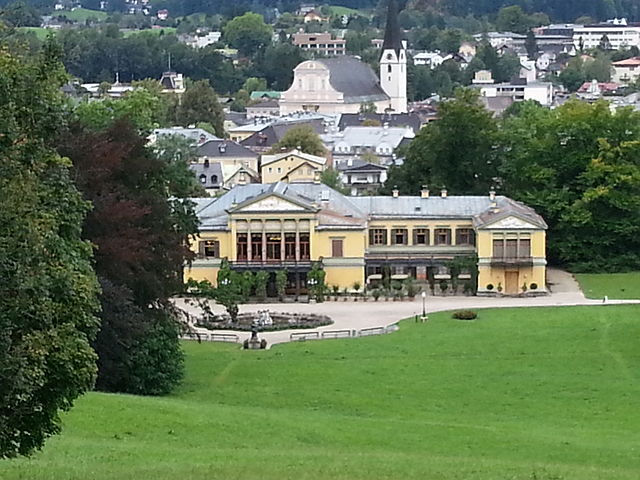
Kaiservilla in Bad Ischl, Austria: the summer residence of Emperor Franz Joseph I. Kaiserville, Bad Ischl, Austria. By Blue tornadoo CC-BY-SA-3.0, via Wikimedia Commons
How would Russia respond? That morning the tsar presided over a meeting of the Russian Grand Council where it was agreed to mobilize the thirteen army corps designated to act against Austria. By afternoon ‘the period preparatory to war’ was initiated and preparations for mobilization began in the military districts of Kiev, Odessa, Moscow, and Kazan.
Simultaneously, Sazonov tried to enlist German support in persuading Austria to extend the deadline beyond 6 p.m., arguing that it was a ‘European matter’ not limited to Austria and Serbia. The Germans refused, arguing that to summon Austria to a European ‘tribunal’ would be humiliating and mean the end of Austria as a Great Power. Sazonov insisted that the Austrians were aiming to establish hegemony in the Balkans: after they devoured Serbia and Bulgaria Russia would face them ‘on the Black Sea’. He tried to persuade Sir Edward Grey that if Britain were to join Russia and France, Germany would then pressure Austria into moderation.
How would Britain respond? Sir Edward Grey gave no indication that Britain would stand shoulder-to-shoulder with the Russians in a conflict over Serbia. His only concern seemed to be to contain the crisis, to keep it a dispute between Austria and Serbia. ‘I do not consider that public opinion here would or ought to sanction our going to war over a Servian quarrel’. But if a war between Austria and Serbia were to occur ‘other issues’ might draw Britain in. In the meantime, there was still an opportunity to avert war if the four disinterested powers ‘held the hand’ of their partners while mediating the dispute. But the report he received from St Petersburg was not encouraging: the British ambassador warned that Russia and France seemed determined to make ‘a strong stand’ even if Britain declined to join them.
When the Austrian minister received the Serb reply at 5:58 on Saturday afternoon, he could see instantly that their submission was not complete. He announced that Austria was breaking off diplomatic relations with Serbia and immediately ordered the staff of the delegation to leave for the railway station. By 6:30 the Austrians were on a train bound for the border.
That evening, in the Kaiservilla at Bad Ischl, Franz Joseph signed the orders for mobilization of thirteen army corps. When the news reached Vienna the people greeted it with the ‘wildest enthusiasm’. Huge crowds began to form, gathering at the Ringstrasse and bursting into patriotic songs. The crowds marched around the city shouting ‘Down with Serbia! Down with Russia’. In front of the German embassy they sang ‘Wacht am Rhein’; police had to protect the Russian embassy against the demonstrators. Surely, it would not be long before the guns began firing.
Gordon Martel is a leading authority on war, empire, and diplomacy in the modern age. His numerous publications include studies of the origins of the first and second world wars, modern imperialism, and the nature of diplomacy. A founding editor of The International History Review, he has taught at a number of Canadian universities, and has been a visiting professor or fellow in England, Ireland and Australia. Editor-in-chief of the five-volume Encyclopedia of War, he is also joint editor of the longstanding Seminar Studies in History series. His new book is The Month That Changed The World: July 1914.
Subscribe to the OUPblog via email or RSS.
Subscribe to only history articles on the OUPblog via email or RSS.
The post The month that changed the world: Saturday, 25 July 1914 appeared first on OUPblog.


By: Kirsty,
on 7/24/2014
Blog:
OUPblog
(
Login to Add to MyJacketFlap)
JacketFlap tags:
Books,
History,
military history,
World,
austria,
British,
This Day in History,
Europe,
wwi,
World War One,
first world war,
hungary,
Serbia,
*Featured,
serbian,
UKpophistory,
gordon martel,
july 1914,
the month that changed the world,
martel,
july crisis,
Berchtold,
Edward Grey,
Austria-Hungary,
Austrian ultimatum,
Sazonov,
sergey,
Add a tag
July 1914 was the month that changed the world. On 28 June 1914, Archduke Franz Ferdinand was assassinated, and just five weeks later the Great Powers of Europe were at war. But how did it all happen? Historian Gordon Martel, author of The Month That Changed The World: July 1914, is blogging regularly for us over the next few weeks, giving us a week-by-week and day-by-day account of the events that led up to the First World War.
By Gordon Martel
By mid-day Friday heads of state, heads of government, foreign ministers, and ambassadors learned the terms of the Austrian ultimatum. A preamble to the demands asserted that a ‘subversive movement’ to ‘disjoin’ parts of Austria-Hungary had grown ‘under the eyes’ of the Serbian government. This had led to terrorism, murder, and attempted murder. Austria’s investigation of the assassination of the archduke revealed that Serbian military officers and government officials were implicated in the crime.
A list of ten demands followed, the most important of which were: Serbia was to suppress all forms of propaganda aimed at Austria-Hungary; the Narodna odbrana was to be dissolved, along with all other subversive societies; officers and officials who had participated in propaganda were to be dismissed; Austrian officials were to participate in suppressing the subversive movements in Serbia and in a judicial inquiry into the assassination.
When Sazonov saw the terms he concluded that Austria wanted war: ‘You are setting fire to Europe!’ If Serbia were to comply with the demands it would mean the end of its sovereignty. ‘What you want is war, and you have burnt your bridges behind you’. He advised the tsar that Serbia could not possibly comply, that Austria knew this and would not have presented the ultimatum without the promise of Germany’s support. He told the British and French ambassadors that war was imminent unless they acted together.
But would they? With the French president and premier now at sea in the Baltic, and with wireless telegraphy problematic, foreign policy was in the hands of Bienvenu-Martin, the inexperienced minister of justice. He believed that Austria was within its rights to demand the punishment of those implicated in the crime and he shared Germany’s wish to localize the dispute. Serbia could not be expected to agree to demands that impinged upon its sovereignty, but perhaps it could agree to punish those involved in the assassination and to suppress propaganda aimed at Austria-Hungary.
Sir Edward Grey was shocked by the extent of the demands. He had never before seen ‘one State address to another independent State a document of so formidable a character.’ The demand that Austria-Hungary be given the right to appoint officials who would have authority within the frontiers of Serbia could not be consistent with Serbia’s sovereignty. But the British government had no interest in the merits of the dispute between Austria and Serbia; its only concern was the peace of Europe. He proposed that the four ‘disinterested powers’ (Britain, Germany, France and Italy) act together at Vienna and St Petersburg to resolve the dispute. After Grey briefed the cabinet that afternoon, the prime minister concluded that although a ‘real Armaggedon’ was within sight, ‘there seems…no reason why we should be more than spectators’.
Nothing that the Austrians or the Germans heard in London or Paris on Friday caused them to reconsider their course. In fact, their general impression was that the Entente Powers wished to localize the dispute. Even from St Petersburg the German ambassador reported that Sazonov’s reference to Austria’s ‘devouring’ of Serbia meant that Russia would take up arms only if Austria seized Serbian territory and that his wish to ‘Europeanize’ the dispute indicated that Russia’s ‘immediate intervention’ need not be anticipated.
Berchtold made his position clear in Vienna that afternoon: ‘the very existence of Austria-Hungary as a Great Power’ was at stake; Austria-Hungary must give proof of its stature as a Great Power ‘by an outright coup de force’. When the Russian chargé d’affaires asked him how Austria would respond if the time limit were to expire without a satisfactory answer from Serbia, Berchtold replied that the Austrian minister and his staff had been instructed in such circumstances to leave Belgrade and return to Austria. Prince Kudashev, after reflecting on this, exclaimed ‘Alors c’est la guerre!’
Gordon Martel is a leading authority on war, empire, and diplomacy in the modern age. His numerous publications include studies of the origins of the first and second world wars, modern imperialism, and the nature of diplomacy. A founding editor of The International History Review, he has taught at a number of Canadian universities, and has been a visiting professor or fellow in England, Ireland and Australia. Editor-in-chief of the five-volume Encyclopedia of War, he is also joint editor of the longstanding Seminar Studies in History series. His new book is The Month That Changed The World: July 1914.
Subscribe to the OUPblog via email or RSS.
Subscribe to only history articles on the OUPblog via email or RSS.
The post The month that changed the world: Friday, 24 July 1914 appeared first on OUPblog.


By: VictoriaD,
on 5/13/2014
Blog:
OUPblog
(
Login to Add to MyJacketFlap)
JacketFlap tags:
Music,
Austria,
gmo,
oxford music online,
Ukraine,
OMO,
eurovision song contest,
*Featured,
TV & Film,
Arts & Leisure,
Grove Music,
Eurovision,
Online products,
Crimea,
Grove Music Online,
Conchita Wurst,
Kallay-Saunders,
Philip Bohlman,
Rise like a Phoenix,
song contest,
conchita,
wurst,
Add a tag
By Philip V. Bohlman
4–10 May 2014. The annual Eurovision week offers Europeans a chance to put aside their differences and celebrate, nation against nation, the many ways in which music unites them. Each nation has the same opportunity—a “Eurosong” of exactly three minutes, performed by no more than six musicians or dancers, in the language of their choice, national or international—to represent Europe for a year. Since its founding in 1956, one of the deepest moments of the Cold War, as Soviet tanks prepared to enter Hungary and Czechoslovakia, the Eurovision Song Contest (ESC) has provided a counterpoint to European politics, providing a moment when Europeans witnessed claims to a common Europeanness.
In early spring 2014, however, as the Ukraine crisis unfolded, the ESC seemed deaf to the deterioration of European politics. A few songs expressed soft nationalism; hardly any made more than a mild gesture toward human rights. Granted, the competitive run of most national entries—through local, regional, and then national competitions—began before the Ukraine crisis, before the occupation of the Maidan in Kyiv, the Russian annexation of the Crimea, and the violent turn of separatism in Eastern Ukraine. The Eurovision Song Contest, nonetheless, had lost its moral compass. It was veering dangerously close to irrelevance for a Europe in crisis.

The Trophy of the 2014 Eurovision Song Contest. Photo by Thomas Hanses (EBU). 10 May 2014 . © European Broadcasting Union.
All that changed during Eurovision week. Though Austria’s Conchita Wurst, the female persona of 25-year-old singer Tom Neuwirth, had captured the attention of many with her sincere flamboyance, she was favored by few and shunned by many, particularly the countries of Eastern Europe. As the evening of the Grand Finale arrived, however, few doubted that Conchita Wurst would emerge victorious, and many realized that their worst fears were about to be realized. Europe had found Conchita’s voice, and she truly did “Rise Like a Phoenix” from the stage of the Copenhagen Eurovision stage.
As I write this blogpost in the immediate wake of the Grand Finale, the explanations and evaluations of Conchita Wurst’s victory at the 2014 Eurovision Song Contest spread across the European media and beyond. Standing on stage in a gown bathed in golden glitter, the bearded Conchita sang powerfully and with full conviction that there was more at stake than finding the right formula for the winning song. “This night is dedicated to all who believe in peace and freedom,” she proclaimed upon receiving the trophy. Supporters and detractors alike saw the moment as evidence that the queering of the ESC had finally and fully come of age. Eurovision historian, Jan Feddersen, had predicted as much in the Berlin liberal newspaper, tageszeitung, the day before. The queering of the ESC had given common meaning to Europe. Feddersen writes: “One communicates throughout the year. What could be a greater cultural flow of Europeanness, even independent of the borders of the European Union” (taz.europa, 9 May 2014, p. 9).
The political and aesthetic trajectory of queering, of course, is precisely not to come of age, rather to engender and regender critical questions of identity and ideology. It is this moving with and beyond queering that Conchita Wurst’s victory signals. The winning song, “Rise Like a Phoenix,” provides, thus, an anthem of a Europe of post-queerness. The Eurosong and the tens of millions who embrace it as their own enter a European space opened by diversity.
Click here to view the embedded video.
In the months and years before Conchita Wurst’s victory on Saturday night, there were probably few grounds that would lead one to predict a winning song for Austria. The self-styled “Land of Music,” Austria simply could not figure out the Eurovision Song Contest. In recent years, it had sent wacky folk-like music and banal power ballads, only occasionally passing beyond the semi-final competitions. For much of the 2010s, Austria sent no entry at all. If Austria was perplexed about its musical presence in the ESC, Conchita Wurst was not. Born in Styria, Tom Neuwirth dedicated himself to a music of difference, a music that provoked, and a music that did political work. As the drag queen, Conchita Wurst (most readers will recognize “Wurst” as the German word for sausage, but in Austria, it is also commonly used in the phrase, “es ist mir wurst,” meaning “it’s all the same to me”), performs songs of action, directed against prejudice and mustered for diversity. There is no contradiction when queerness and nationalism occupy common ground, all the more in an Austria that provides shelter to a higher percentage of refugees than any other European nation. When Conchita remarked upon qualifying after the second semi-final on May 8, announcing proudly that “I’m going to do all I can for my country,” there was no irony.
The Eurovision Song Contest 2014 had found its voice. The ESC had returned to Europe. At a critical moment of struggle in Ukraine, when right-wing European political parties on the eve of European parliamentary elections are calling for their nations to retreat from Europe, the ESC has reclaimed its relevance, and it has done so by recognizing its historical foundations. In many ways, Conchita Wurst, performing as a transvestite, offers a less provocative stage presence than the transsexual Dana International, who won for Israel in 1998 and competed again in 2011. ESC queerness begins to demonstrate the attributes of a historical longue durée, and it is for these reasons that it elevates a music competition to a European level on which it is one of the most visible targets for official Russian homophobia and the violation of human rights elsewhere in Europe. It is a return to that history that “Rise Like a Phoenix” so powerfully signifies.
On Saturday night, there were other entries that took their place in the more diverse, post-queer Europe given new and different meaning by Conchita Wurst. Political meaning accrued to songs in which it had previously remained neutral (e.g., Pollapönk’s “No Prejudice” for Iceland, and Molly’s “Children of the Universe” for the United Kingdom). Several quite outstanding songs came to envoice a fragile Europe in need of change (e.g., Elaiza’s mixture of cabaret and klezmer in “Is It Right” for Germany, and András Kállay-Saunders’s “Running” for Hungary). Kállay-Saunders transformed the narrative of an abused child to a call for action in European human rights. The son of Pharaoh Saunders, Kállay-Saunders is a stunning presence on stage, an African American Hungarian, calling attention to the violation of human rights while representing a nation sliding to the right, so much so that many Hungarian artists, musicians, and intellectuals (e.g., András Schiff) will not enter their homeland.
Click here to view the embedded video.
Click here to view the embedded video.
On Sunday morning, 11 May, the Berlin tageszeitung opened its lead article on the Eurovision Song Contest with the celebratory claim, “there is hope for Europe.” It is perhaps too early to claim that we are witnessing music and nationalism in a new key. From early April until the Grand Finale, I gave a regular series of newspaper, radio, and television interviews in Germany, where I currently teach as Franz Rosenzweig Professor at the University of Kassel, and I realize only now that my own observations about nationalism and the ESC underwent radical change, all the more as Conchita Wurst brought a new Europe into focus (see, e.g., the interview with the Austrian-German-Swiss network, 3sat, just before the Grand Finale). The European Broadcasting Union (EBU) itself had predicted 120 million viewers, but estimates the day after the Grand Finale raised the number to 180 million, a fifty-percent increase. Nationalisms proliferate often; rarely do they subside. In the Ukraine crisis, each side accuses the other of being nationalistic, laying claim to their own right to be nationalistic. These are the nationalisms in the old key, collapsing in upon themselves. In contrast it may be a quality of a post-queer Eurovision Song Contest that it can foster a nationalism of tolerance and diversity, and that its song for Europe truly rises like a phoenix, enjoining the many rather than the few to join the chorus.
Philip V. Bohlman is Mary Werkman Distinguished Service Professor of Music and the Humanities at the University of Chicago. Currently, he serves as Franz Rosenzweig Professor at the University of Kassel, and on the editorial board of Grove Music Online. He writes widely on music and nationalism, most recently Focus: Music, Nationalism, and the Making of the New Europe (Routledge 2011). He is writing the book, Music after Nationalism, for Oxford University Press, a project for which he received a Guggenheim Fellowship in 2013.
Oxford Music Online is the gateway offering users the ability to access and cross-search multiple music reference resources in one location. With Grove Music Online as its cornerstone, Oxford Music Online also contains The Oxford Companion to Music, The Oxford Dictionary of Music, and The Encyclopedia of Popular Music.
Subscribe to the OUPblog via email or RSS.
Subscribe to only music articles on the OUPblog via email or RSS.
The post “There Is Hope for Europe” – The ESC 2014 and the return to Europe appeared first on OUPblog.

Wilkommen in Österreich! I stopped counting after detecting thirty bites on the first arm. It had been my idea to camp deep in the forest instead of the open ground near the highway. It was a mosquito invasion so comprehensive that … Continue reading →

By:
Paula Becker,
on 1/15/2013
Blog:
Whateverings
(
Login to Add to MyJacketFlap)
JacketFlap tags:
children,
Links,
kids,
comics,
cartoon,
General Illustration,
Samples,
paula j. becker,
paula becker,
Austria,
festival,
Cartoons & Comics,
chirp magazine,
Owlkids,
Austrian,
paulajbecker,
body-painting,
january 2013,
Add a tag
Hi everybody! I have a few things that are out in print this month so I wanted to get them up on the blog.
First up is a spread I did for the Jan-Feb ’13 issue of Chirp magazine. This was a lot of fun to assemble and figure out, to have characters applying and wearing body paint. I learned a lot about the art form just doing research. Some samples of the spread are below. Thank you, Owlkids, for the fun project!


Closer…

Closer again.

Every day we as writers face fears.
Fear of rejection, fear of reviews, fear you'll never land an agent or editor, fear that your next book won't sell, fear your agent or editor won't approve those edits.
The list is endless. But the only way to overcome those fears is to face them. While I was in Europe this summer, I filmed this short vlog with tips on how to face those fears.
Do you have any tips that you'd like to share?

By: Jerry Beck,
on 4/23/2012
Blog:
Cartoon Brew
(
Login to Add to MyJacketFlap)
JacketFlap tags:
Music Videos,
Austria,
Abstract,
Stop Motion,
ISO,
Jack Featherstone,
Jamie Caliri,
LWZ,
Markus Wagner,
Martin Lorenz,
Maxwell Sorensen,
Stefan Salcher,
Will Samuel,
Add a tag
Simian Mobile Disco by Cerulean
Jack Featherstone and Will Samuel designed, directed and animated this abstract video at London’s ISO studio. (Thanks to Felipe Robles for the link.)
Cpt. Metal by Die Arzte
Vienna, Austria collective LWZ, comprised of Martin Lorenz, Stefan Salcher and Markus Wagner, created Cpt. Metal for German punk band Die Arzte.
Te Koop / A Vendre by Pree
Maxwell Sorensen animated this piece over the last two months, during evenings and on weekends. Created entirely in Photoshop and After Effects after scanning “a big pile of real paper textures to keep it more organic”. Sorensen spends his days interning on stop-motion projects at Hornet Inc.
The Rifle’s Spiral by The Shins
That’s Jamie Caliri’s new video for Portland-based indie rock band, The Shins. Caliri, best known for his Lemony Snicket end titles, created this surreal stop-motion animation inspired by Edward Gorey illustrations and Martin Scorsese’s Hugo. Go here to watch the making of video.
Cartoon Brew |
Permalink |
No comment |
Post tags: Abstract, Austria, ISO, Jack Featherstone, Jamie Caliri, LWZ, Markus Wagner, Martin Lorenz, Maxwell Sorensen, Stefan Salcher, Will Samuel
By: Dave,
on 11/9/2009
Blog:
inspiration from vintage kids books and timeless modern graphic design
(
Login to Add to MyJacketFlap)
JacketFlap tags:
illustration,
travel,
Canada,
Africa,
UK,
France,
Poland,
germany,
1950s,
finland,
vintage,
posters,
1960s,
1970s,
Found design,
israel,
switzerland,
Austria,
Argetina,
Add a tag

1. Come to Africa - Designed by Gerard van de Voort - c1975
How about virtual tour around the world to start off the week? I dug up a handful of travel related posters from 1950s -1970s for all the desk jockeys that are itching to get out of town. Enjoy!
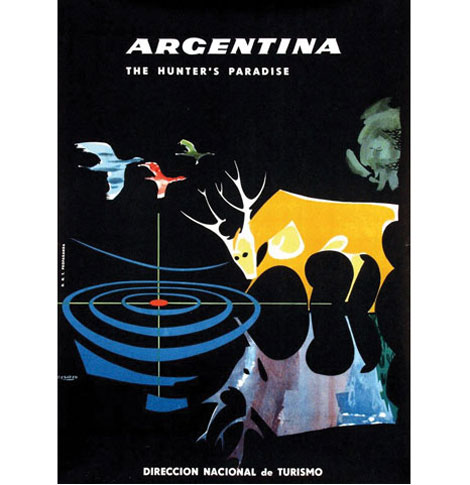
2.
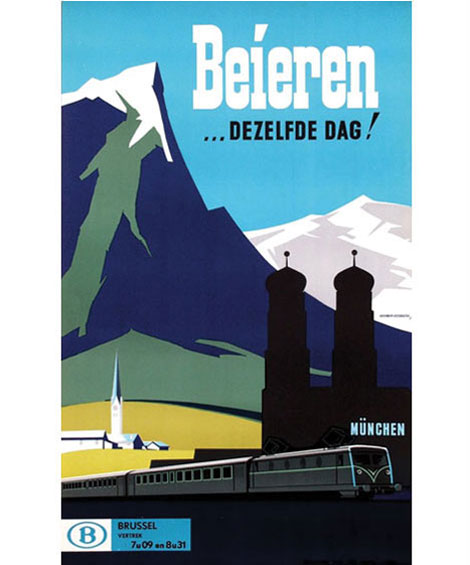
3.
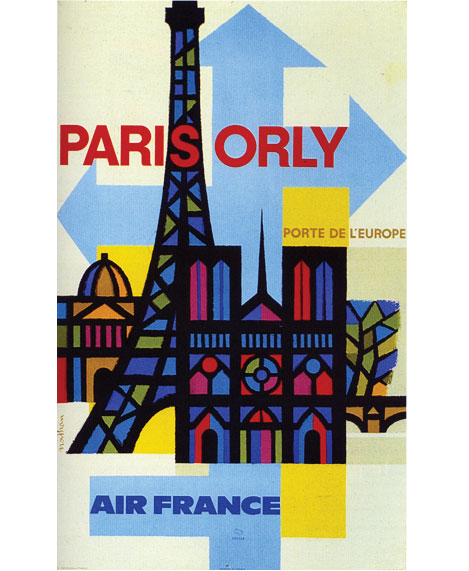
4.
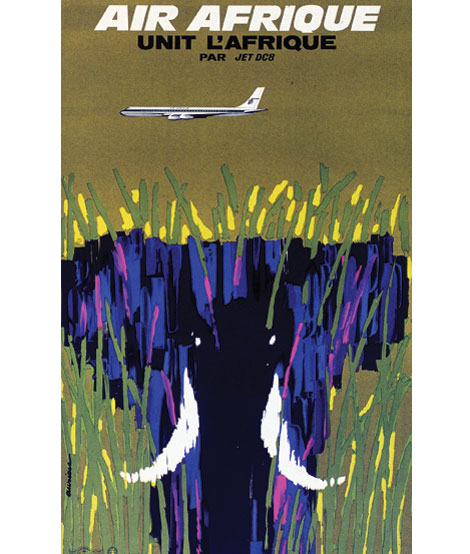
5.
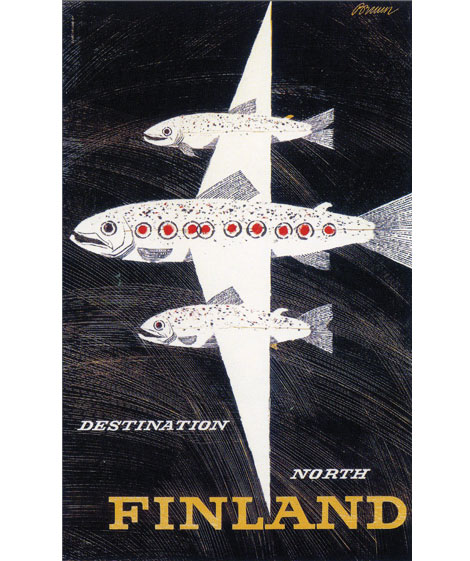
6.
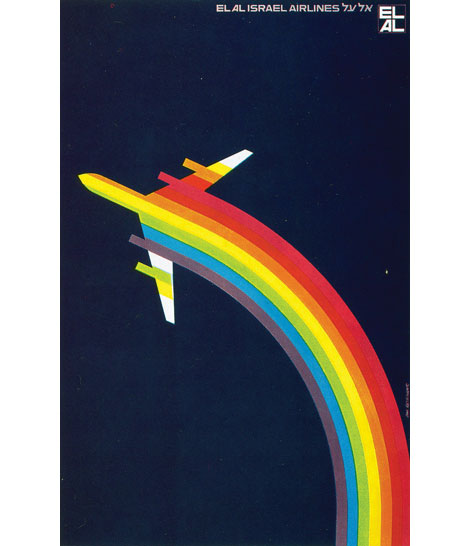
7.
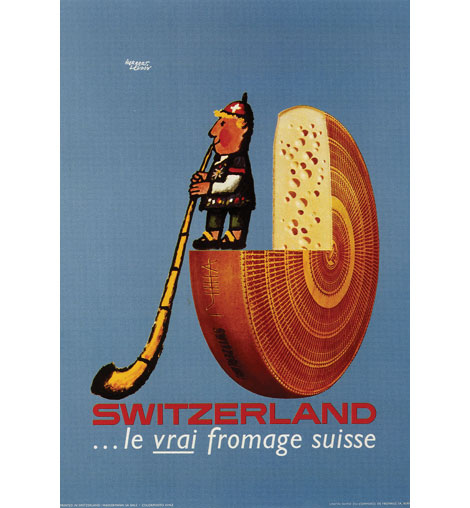
8.
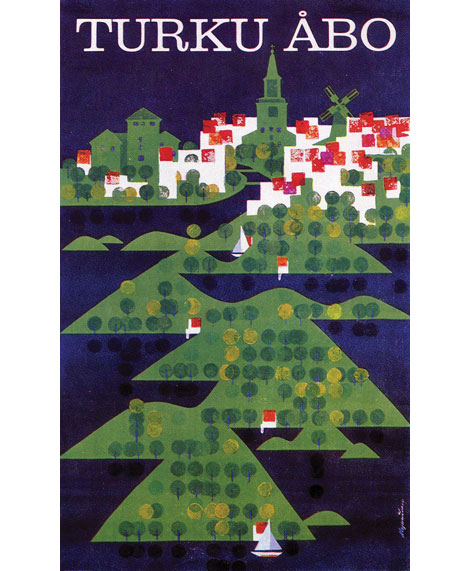
9.
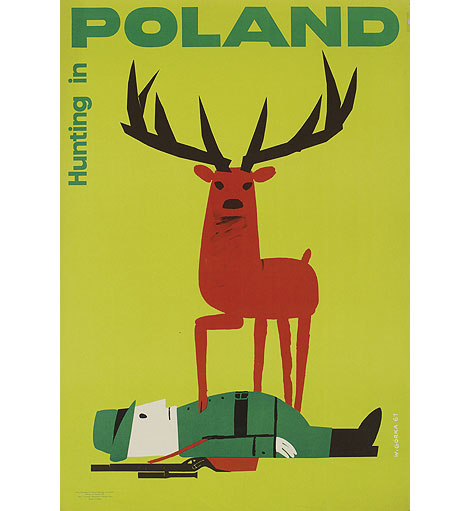
10.
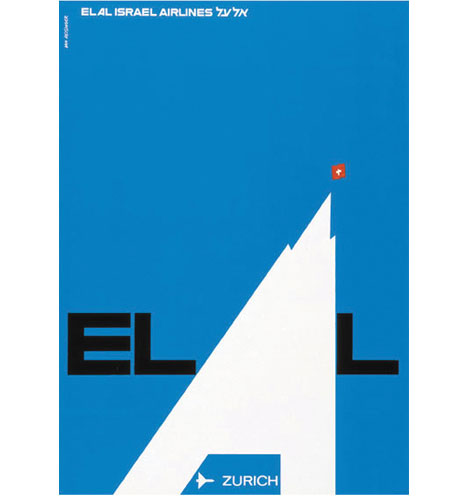
11.
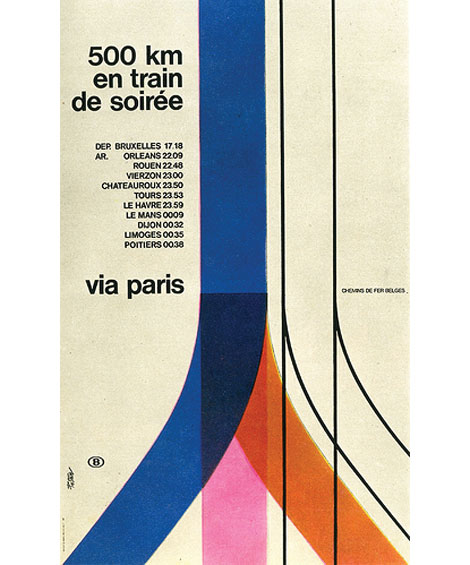
12.
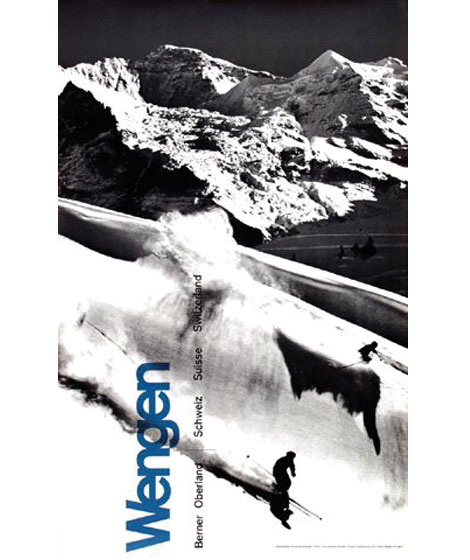
13.

14.

15/16.

17/18.
2. Argentina c1950 -Poster artist - Cesareo 3. Beieren c1960- Designed by Herman Verbaere 4. Paris-Orly for Air France c1962- Design & Illustration by Jaques Nathan Garamond 5. Air Afrique c1965- Designed and illustrated by Jacques Auriac 6. Finland print for Finnair c1958 - Design by Erik Bruun 7. Rainbow poster for EL AL Israel Airlines - Design by Dan Reisinger 8. Switzerland c1967 - Design by Herbert Leupin 9. Turku Abo - Tourist poster for the Finnish town of Turku c1966?- Design by Marti Mykkanen 10. Hunting in Poland c1961 - Design by Wiktor Gorka 11. Switzerland poster for EL AL Israel Airlines - Design by Dan Reisinger 12. Poster for Belgian Railways c1966 - Design by Wictor Langer 13. Wengen Switzerland poster c1965 - Design by Martin Lauterburg + Fritz Lauener 14. Austria poster for Pan Am Airlines c1971 - Design by Chermayeff & Geismar 15/16. Israel: The land of the Bible produced for the State of Israel Tourist Centre - Design by Jean David 17. Travel Royal Blue c195? - Design & illustration by Daphne Padden 18. Great Canadian North -Pacific Western Airlines - Anonymous c1960
(images 1,2,3 via Van Sabben auctions) image #12 via grid studio , image #14 via the excellent Container List, image #17 via Larking About
——————–
Also worth checking: David Klein TWA posters.
Not signed up for the Grain Edit RSS Feed yet? Give it a try. Its free and yummy.
——————–
No Tags
Share This
Congrats to B. Rane! She is the winner in the Photo-Lettering giveaway.
Grain Edit recommended reading: A Russian Diary
©2009 Grain Edit - catch us on Facebook and twitter

In Austria, I was invited to participate in an International Art Symposium entitled:"Freistat Burgestein 2005" (International Art Symposium) from July 9-18, 2005 at Laengenfeld, Tirol, Austria. I had to create works which will later be exhibited in Vienna, Telfs, Miemig, :Laegenfeld
Below is where I stayed among other International artists:

And here is my small but efficient studio in Langelfeld, Austria provided by Provita Alpina.

Here I am printing in my studio-
and getting ready for the exhibit in the Tyrolean Alps:

I created my Traveling scroll series here as shown below and also participated in the outdoor exhibit as well as in the Austrian WerkMuseum in the city.

Finally, one of the reviews in an Austrian Newspaper in Tyrol. ( in German)
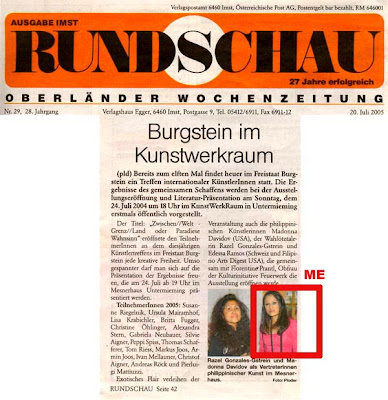

Another cool thing about being a reviewer is that you get to read a book before anyone else. (Full disclosure: excuse the fingerprints: the cover of the advanced reading copy is shiny.) Songs Without Words is the new book due out in September from Ann Packer. She wrote The Dive From Clausen’s Pier. Like that book, Songs is a complex tale of humans trying to make choices with both their hearts and their heads. Suicide is a theme that runs all through this book, and there were times I was reluctant to read it, not wanting to watch one of the characters I had come to love feel pain.
The more I write, the more I find the writing/editing part of my brain won’t shut up when I read, yammering on about awkward dialog, clunky exposition, etc. It only shuts up when I read a really good book . And with Songs Without Words it was very, very quiet.
 Subscribe with
Subscribe withJacketFlap's
Children's
Publishing
Blog Reader







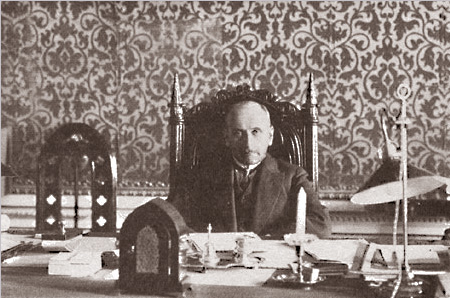



























The Vienna Prater is GREAT!!! I am going to force Lance Fensterman to allow me to go to this show. Austria is wonderful, wonderful.